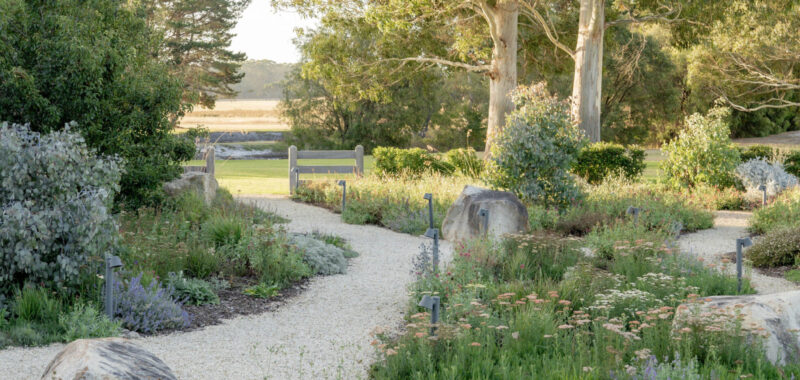Drift Landscape Studio director Patrick O’Neil and his parents have owned a magical 30-acre property in Albany since 1992.
Back then, it was made up of remnant paddocks that had been subdivided off a former farmland. But these days it’s a dreamy wedding venue, known as The Gardens at Bullimah.
On the edge of the converted hay shed, there’s a 1100-square-metre stretch of land that’s especially enchanting, where Patrick sought to create a sustainable and naturalistic garden filled with ‘soft’ planting — instead of the typical spiky, hard landscaping you typically see in xeric (dry) gardens.
‘Only a few years prior I’d returned from my study in the UK and was very much influenced by what was referred to as the ‘New Perennial’ movement at that time. I wanted to try and do a similar thing, but with drought-performing soft-stemmed plants,’ Patrick says.
‘My original hope was to make a completely xeric garden. That hasn’t happened as yet, but we get closer every year.’
The resulting garden now reveals intermingled plants that seem randomly mixed and squashed together, much like a dreamy meadow.
In reality, the groupings of soft herbaceous species, grassy plantings, and perennial flowers have been carefully composed to produce a rich tapestry that changes beautifully with the seasons.
‘I had to ensure that we weren’t introducing any weeds. Given the planting isn’t native, that is certainly a consideration for a garden like this in which there are 40 or more different species,’ Patrick says.
Embracing the project as a chance to experiment, Patrick brought together a number of ‘unusual perennials’ from regions like South Africa, Mexico, California and the Mediterranean for their ability to flourish under low-water conditions.
Prairie grasses such as Schizachyrium scoparium (little blue stem) and Andropogon gerardii (big blue stem) form the backbone of the design thanks to their upright resilient forms. In the sea of flowers, Scabiosa drakensbergensis (pin cushion), Achillea millefolium ‘Salmon Beauty’ (yarrow) and Knautia arvensis (field scabious) provide pops of colour against chalky backdrop of crushed limestone paths.
‘Large granite boulders provide the form that hold the soft planting together. They were rescued from the earthworks when we completed our house build in Albany, and brought out to Bullimah, so it was nice to use a bit of our local Mount Clarence in the garden,’ Patrick adds.
The garden has come to life through plenty of trial and error for the landscape designer, who is hopeful that one day, the garden might be able to make it all the way through summer unwatered.
‘Around late December to early January, the garden is at its peak and it’s just a pleasure to be in it. The flowering seems endless, and the late sun floats beautifully through the inflorescences.’

